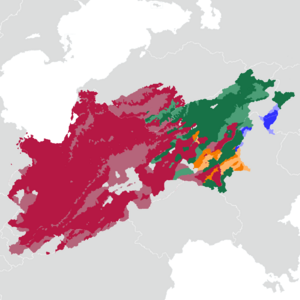Koman people
| . XOMANÆ., Khomanə | |
|---|---|
 Approximate distribution of the Koman ethnic groups | |
| Total population | |
approx. 60–70 million (estimates vary)
| |
| Regions with significant populations | |
| 45,102,822(2020) | |
| 12,030,451(2020) | |
| 4,500,000 ≥ | |
| 2,277,500 | |
| 128,300 | |
| 113,518 | |
| 103,334 | |
| 17,202 | |
| Overseas | 2,000,000 ≥ (disputed) |
| Languages | |
| Koman, Balak, Dawari | |
| Religion | |
| Primarily Shawadii Zarasaism Historically Polytheism and Vaniuan Shamanism | |
| Related ethnic groups | |
| Balaks, Mishars, Gushlis | |
Koman (Koman: . XOMANÆ.; IPA: /xomänə/) is a Vaniuan term for closely related ethnic groups attributed to having a shared origin as descendants of Kalkali speaking groups. Originally formed around the southern Melkanchuta coast during the 11th century, early Koman peoples came to inhabit much of the Tarkhan region and Eastern Vaniua with the expansion of the Great Horde. The Koman people are recognized for their distinctive admixture of pre-Vaniuan and Parshitan ancestries. This amalgamation primarily dates back to the 1st to 5th centuries during the era of the Qom Confederation. Over subsequent centuries, these populations traversed the region, driven by their nomadic way of life and the prevailing political dynamics, further increasing their admixture with other Vaniuan peoples.
Language
The Komans speak the Koman language, a member of the Vaniuan family from the Kalkalic (Northeastern) sub-group of Eastern Vaniuan languages, the language itself is distinguished by its total lack of affricates, fusional nature, large substratum of pre-Vaniuan loanwords and having the peculiarity of being conservative, sharing structural similarities with proto-Eastern Vaniuan. Apart from Koman, many speakers mainly inhabiting the federal state of Tarashik in Balakia are proficient in Balak as means of a lingua franca. Other languages include Qalari spoken by several tribes of the Tamyiran banner and the Dawari language spoken by a reduced cluster in the Tarkhan Mountains.
Historically, many Komans of the upper class and nobility were known for their proficiency in several languages, these included Ohanian, Kaatian and even Mishar. today most Komans inhabiting Komania are either monolingual or present a level of proficiency in several varieties.
Etymology
The term Koman arose as early as the 12th century, as Shi Oshar conquered the coastal kingdoms of Melkanchuta and established the Great Horde, he applied the term to Tamyiran tribes that previously ruled the Tamir Khanate, it is believed that the term Koman, (Koman Qaman; . Qaman .) means "of the coast" indicating their geographic location before drastically expanding eastwards. While initially not used as an ethnonym, it assured the differentiation between the tribes whom formerly inhabited the region under the name Qomandi. Komans, however, prefer to use of Tamir as endonym.
The endonym Tamir is thought to be a tribal name referring to the Tamir Khanate. A consensus of its origin is, however, still highly debatable. According to the Tamirologist and linguist Ayran Ğəren, the term Tamir might have derived from the proto-Eastern Vaniuan word for iron, reconstructed as *tɒmæɰ, following his theory, final /ɰ/ a common ending in the reconstructed corpus of PEV, suggests a possible proto-variant in which, following the phonetical developments of the Tamiric languages, might have ended with a rhotic consonant. The accuracy of his theory is still undergoing debate. A general agreement over its origin is the possibility of having pre-Vaniuan roots, a seeming possibility shown by the extensive contact between proto-Eastern Vaniuans and pre-Vaniuans, further proven by a large lexicon of pre-Vaniuan terms found in Koman.
History
According to Koman lore, the ancestors of the Komans can be traced back to the inhabitants of the Baykharan region near the Miralayas. Under the Hirim-e Shən, a collection of Koman epics, tells their mythological origin as sons of the Hêray who fell from the 7 corners of the Heavenly Realm and fought Qâdarêm thus saving humanity from annihilation by Muhe. The forefathers of the Komans gradually migrated westwards as several tribal confederations were formed. In the 8th century, the warlord Qazşam Qashir proclaimed the Tamir Khanate which lasted for the next five centuries and played a key role over the migratory patterns of the Komans.
By the 12th century, the gradual fragmentation of the Tamir Khanate consecutively pushed tribes of royal lineage southwards, as the region succumbed to instability other tribes followed the trend. It is known that during the times of Shi Oshar most Koman tribes migrated to the southern coasts of Melkanchuta with lesser tribes settling westwards in what would later give rise to the Xonqori people or Shánḍamir in Koman. Contrary to popular belief, a vast population of Komans already populated the Melkanchutan coasts and where recorded as the Qomandi by several sources.